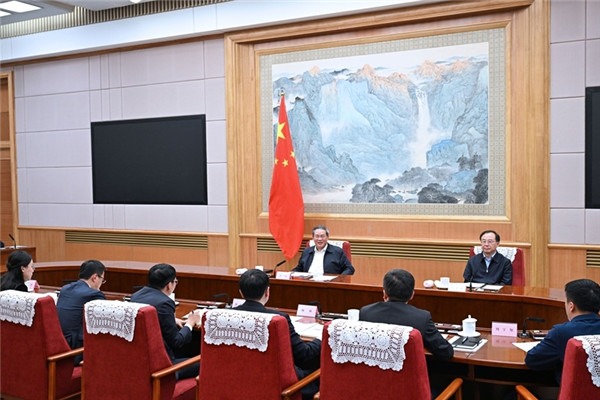Achieving long-term economic goal through fiscal policies

In response to economic uncertainties at home and abroad, China must focus on a long-term goal that transcends immediate reactions and leverages fiscal tools to accelerate the economic shift from debt- and investment-driven to technology- and consumption-driven growth, as well as the upgrading of high-end industrial chains.
In the long run, although China is the world's second-largest consumer market next only to the United States, consumption's contribution to the economy is much lower than that of other advanced economies.
As an important way of countercyclical adjustment, fiscal expenditure will promote the development of new quality productive forces, forming more high-quality products and services. At the same time, fiscal funds can also be converted into enterprises' and residents' income through government investment and consumption, so as to enhance the consumption willingness and capacity of residents and provide fuel for the high-quality development of the economy.
Therefore, the medium- and long-term goal of fiscal policies could be positioned as building a consumption-oriented fiscal and tax system and policy system, and forming the largest consumer market in the world, so as to strengthen China's discourse in global economic governance.
To achieve this target, fiscal policies should be transformed and innovated in light of the evolving situation.
First, the Chinese government should shift its attention from deficit rate to the growth rate of expenditure, ensure the necessary expenditure intensity, and truly leverage the function of countercyclical adjustment.
Second, in an economic downturn, enterprises and residents may lack confidence, so the effect of the tax and fee reduction policy on the income side to stimulate economic growth is limited. The tax and fee reduction policy that emphasized on the income side before should be shifted to the expansion of spending on the expenditure side. At the same time, the revenue policy's focus should be changed from quantity to efficiency.
Third, as China's economy is facing a problem of insufficient demand, it is necessary to shift fiscal support policies to the demand and household side, provide subsidies to specific family groups, and improve the level of social welfare in the household sector.
Additionally, China needs to bolster the role of fiscal policy to stabilize economic expectations and implement an "expansionary fiscal policy" to send a clearer signal.
China should also adjust and announce additional budgets on the basis of the 4 percent deficit ratio in time to ensure the necessary expenditure intensity.
On the one hand, China ought to speed up the implementation of existing fiscal policies and the issuance of bonds to put into tangible economic output such as major infrastructure and municipal engineering as soon as possible.
On the other, it is necessary to promote the growth rate of fiscal expenditure close to the nominal economic growth rate quickly, ahead of market expectations.
In terms of optimizing the policy of debt resolution, the central government should give the quota of debt resolution to local governments in a lump sum according to the actual needs of each area, and support high-risk regional debt resolution and advanced debt resolution.
Although the explicit nature of implicit debt will inevitably push up the statutory debt balance and debt ratio, this does not mean that the risk will increase. Of late, real estate has been in a period of adjustment and transformation, while income from land transfers has declined, resulting in a decrease in the comprehensive financial resources of various regions and an increase in the government debt ratio.
Therefore, it is necessary to optimize the debt risk classification index, and consider excluding the factors of real estate adjustment to evaluate the local debt risk, or redetermine the risk classification index according to the increase of the national local debt ratio due to the adjustment of the national real estate market, so as to solve the problem of the impact of debt indicators on the enthusiasm and ability of local investment.
After withdrawing from some key areas, the government should pay attention to policy convergence, and strictly control the regional scope of new government investment projects from provinces to cities and counties, so as to avoid accidentally hurting the investment of some city and county governments.
Next, a new round of effective investment plans that focus on supporting the eastern region, giving priority to social benefits, while avoiding unprofitable investment and excess capacity, should be started as soon as possible. The source of funding must be statutory debt, not expansion implicit debt.
Specifically, new investment plans should pay attention to areas with continuous population inflow to optimize public services, promote the urbanization of migrant workers, and release the housing and consumption needs of migrant workers.
In line with the trend of an aging population and a declining birthrate, more funds should be invested in the construction of nursing homes and hospital beds, with educational resources allocated according to the distribution of population.
Safety-related fields, such as the renovation of old residential areas and underground pipe networks, the preparation for extreme natural disasters, and areas related to increasing potential economic growth, including new quality productive forces like new infrastructure, also need more investment.
From the central level, the government could explore the establishment of a "real estate stabilization fund", with an initial scale of about 2 trillion yuan ($274 billion), which will be specially used to ensure the delivery of housing, collect and store housing, acquire the land stock of real estate enterprises, and prevent the liquidity risk of real estate enterprises, so as to protect people's livelihood and alleviate the liquidity pressure of real estate enterprises.
Moving forward, the government should promote the linkage reform of the "State-owned assets-finance-social security" system, increase the proportion of State-owned assets handed over to the treasury and specifically use it to improve the level of pension insurance for all residents, especially to raise the level of rural residents' pensions into subsistence allowance, from the current average of 223 yuan per month to about 600 yuan per month step by step.
Such reform should also be expanded to optimize the structure of fiscal expenditure by tilting toward public consumption areas such as medical care, education and pension, so as to solve residents' worries and increase their willingness to consume.
Finally, it is also expected to increase specific subsidies for unemployed college students and families with two children or more, and expand the trade-in subsidy to the sector of service consumption to boost internal demand.
The writer is chief economist at Yuekai Securities and director of the China Chief Economist Forum.
The views do not necessarily reflect those of China Daily.




































